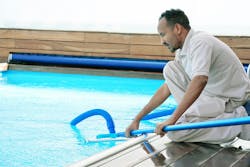Pool & spa care: Best practices for maintenance & chemical use
Summer may have ended but fall and winter are popular times for enjoying hot tubs, indoor pools and spas that stay open year-round, making water treatment chemical safety important regardless of the season. Pool and spa chemicals are necessary to keep these amenities clean of pathogens like E. coli, giardia and algae and protect the system’s infrastructure; however, when misused, they can cause harm. Chemical burns, respiratory issues and eye irritation are a few of the health problems that can be caused by mishandling these chemicals. Implementing proper chemical use and storage best practices can keep both pool and spa facility managers and users safe, while keeping hot tubs and spas clean and sanitized.
Follow professional guidance
The first step to properly maintaining a pool and spa is to review your local pool code. These will vary depending on what city and state your pool and spa are operating in. Codes will include requirements regarding permits, inspections, swim safety ordinances and more depending on how in-depth your regional code is written. It is crucial to review the code for pool and spa chemical requirements such as residual range, pH range and other water quality parameters specific to your area. In addition to following local guidance, it is important to follow the chemical manufacturer’s instructions for application methods and dosage rates of the recreational water treatment chemicals you are utilizing. These may differ from product to product, so review the directions carefully before application.
Frequently test pool & spa water
Regularly test the pool or spa water to ensure it is not developing algae blooms or promoting bacteria or viruses. This will help with the maintenance of appropriate pool chemical levels. It is best practice to always have a stock of water quality testing kits handy to monitor water quality at any given time. There are several different types of testing kits available to purchase that will test different chemicals; be sure to choose the most appropriate kit based on what chemicals are being utilized for the pool and spa.
Common chemicals for frequent monitoring are the chlorine residual, total alkalinity, acidic demand, and pH. As for testing frequency, chlorine and pH should be tested two to three times a week, whereas total alkalinity only needs to be tested once a week. The acidic demand should be tested when pH levels are adjusted, which can be as frequently as weekly considering the frequency of the pH testing.
Disinfect with care
Pools and spas are used for recreation, exercise and relaxation; it is no surprise that bodily fluids often accumulate. Disinfectants such as calcium hypochlorite and sodium hypochlorite play an integral role in pool and spa safety to keep amenities clean. While these are common chemicals for pool and spa managers to handle, it is critical that they are used correctly to ensure effectiveness. To help ensure the disinfectant will work effectively, make sure you are using a product that has not reached its expiration date and using the feeder designed for the specific chemical. Not all chemicals and feeders work together, meaning that choosing the wrong chemical for a feeder can result in an explosion. Pool operators should follow manufacturer recommendations for storing chemicals in both liquid and solid forms. General recommendations are for chlorine chemicals to be stored in a cool, dry, and well-ventilated place. Lastly, the disinfectant that you use needs the optimum pH range to work effectively. During the water testing process, make sure the pH is at a satisfactory level and maintain it at that level before utilizing chlorine to help with its ability to disinfect.
Utilize certified products
Pool and spa chemicals are both critically important and potentially harmful chemicals, so it is important that they work how they claim to. The Model Aquatic Health Code (MAHC) specifies that treatment chemicals for recreational water supplies need to be certified to either NSF/ANSI/CAN 50 or NSF/ANSI/CAN 60. Look for chemical products certified to these standards to ensure that they meet the standard requirements that have been set and widely accepted by the industry. Lastly, be sure to not exceed certified maximum use levels when using any treatment chemicals in spas and pools.
In conclusion, there are many factors pool and spa managers need to consider when caring for these amenities to help protect their guests’ health. Water treatment chemicals are a key tool in spool and spa safety, making education around their use imperative. By following this basic management outline with best practices on pool and spa maintenance, managers can feel confident providing a clean and safe environment for users to continue to enjoy these amenities year-round while also keeping themselves safe.
